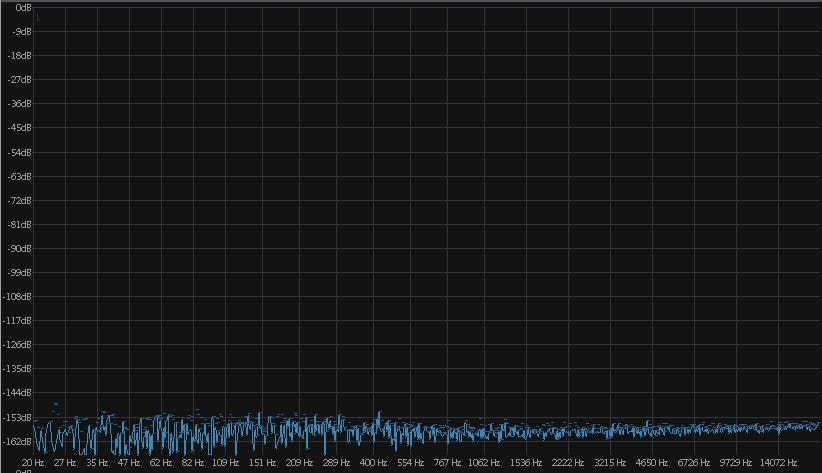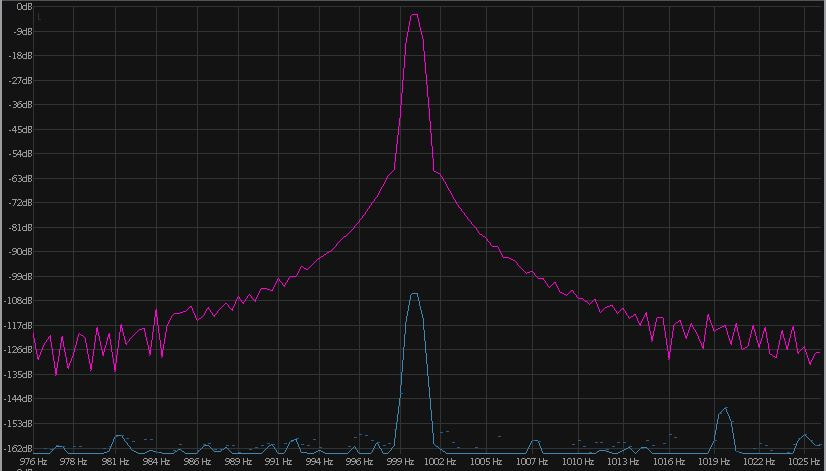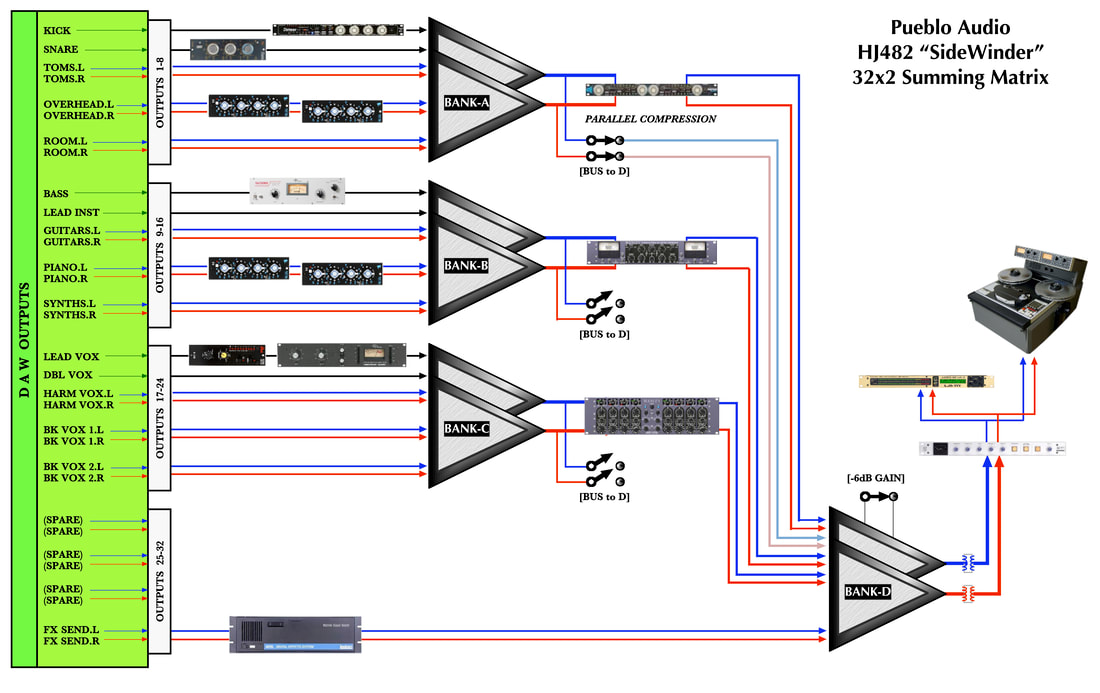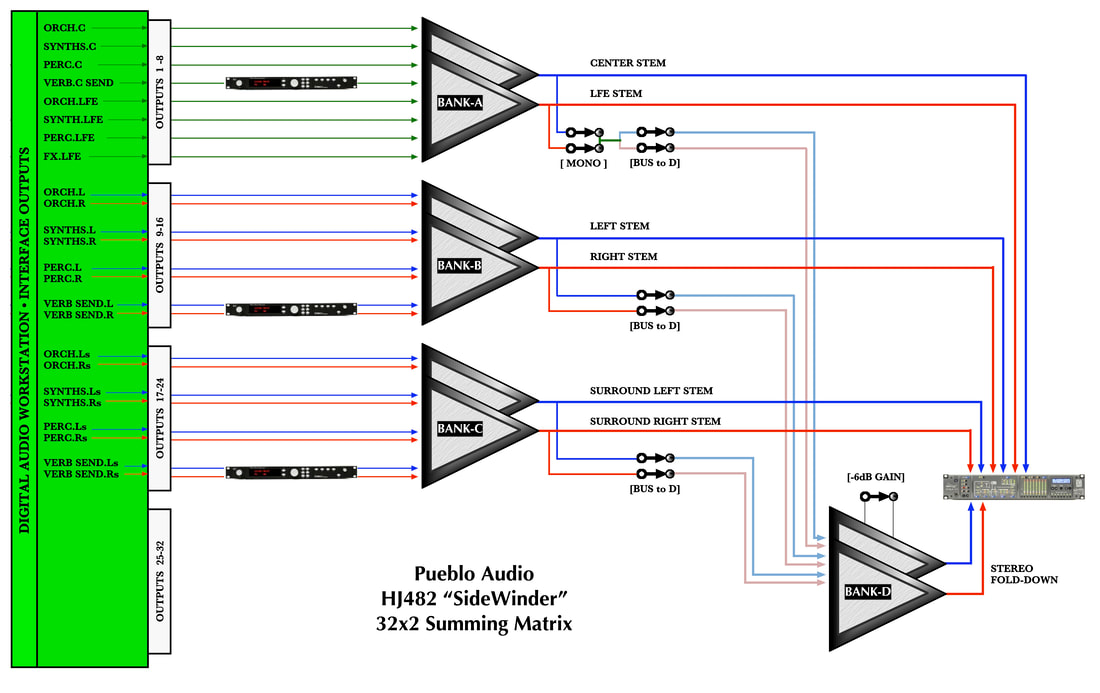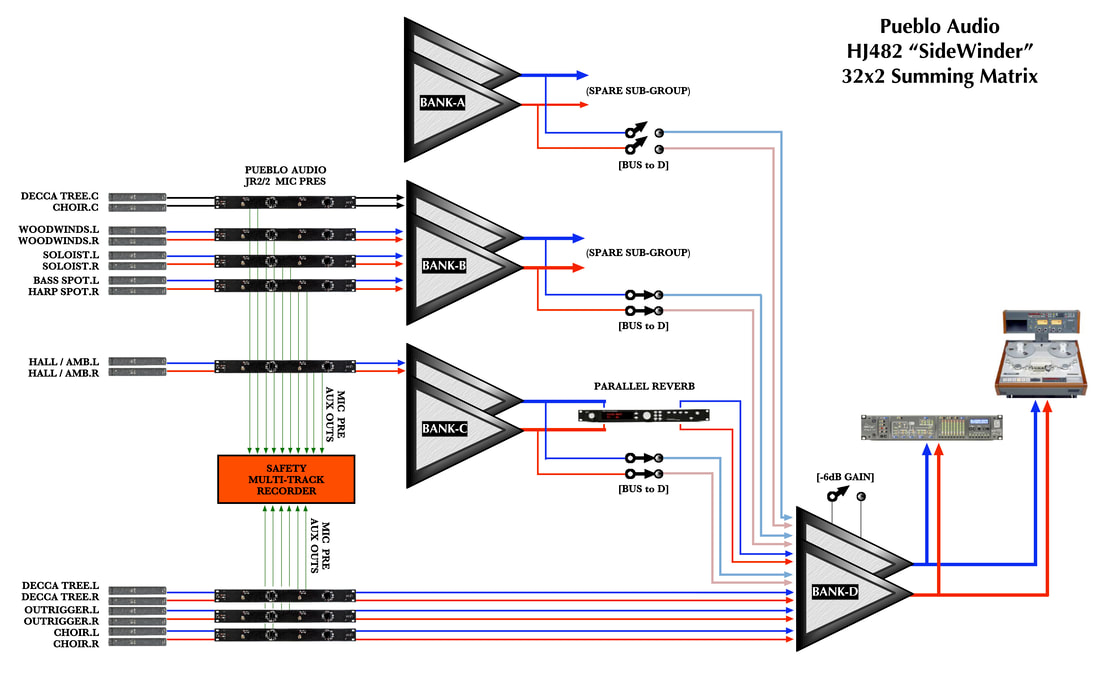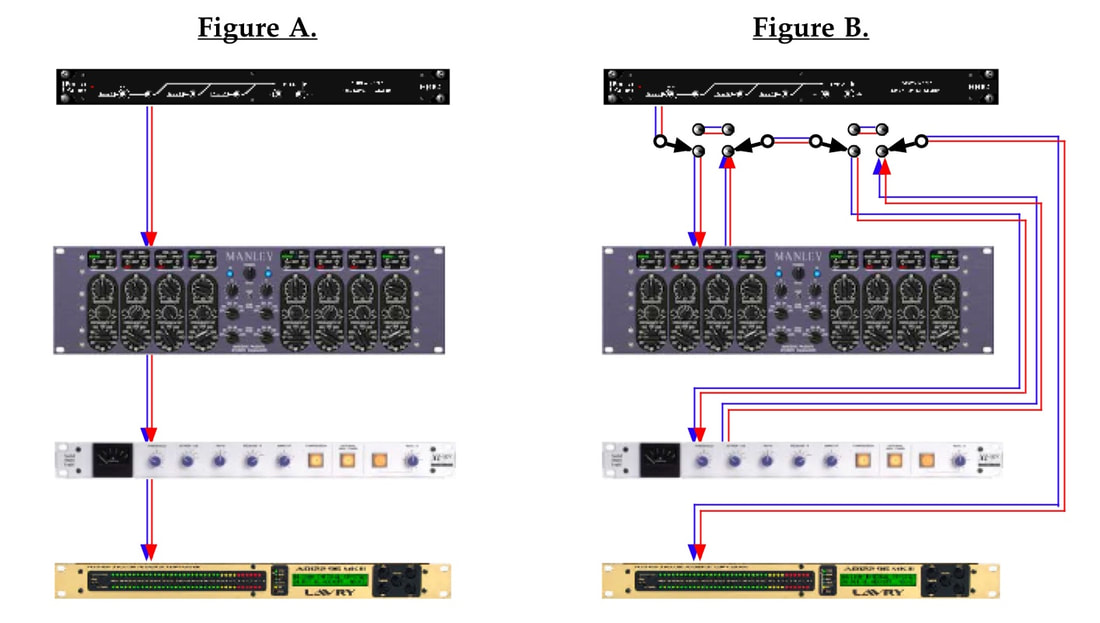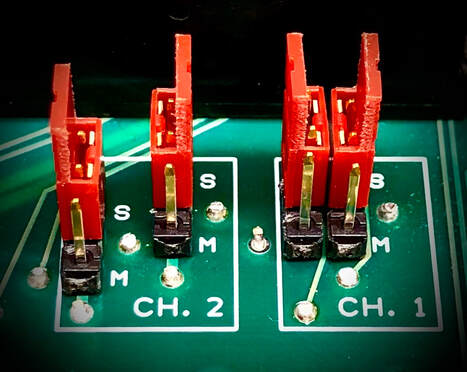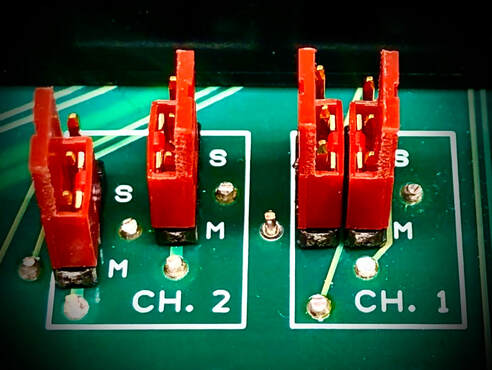HJ482 • SideWinder 32x8x2 Summing Matrix
SKU:
$1,800.00
1800
2300
$1,800.00 - $2,300.00
Unavailable
per item
|
Pueblo Audio is always looking to provide solutions for its client's constantly changing needs. In an era of instant recalls and homogenous ITB production, busy mixers seek to bring higher caliber summing to their hybrid analog work flow. For this we present our newest product - HJ482 "SideWinder", a truly high-performance summing amp with Multi-Buss routings and gorgeous sonics not found in other products. "SideWinder" is offered in several configurations so we invite you to scroll down for details.
|
"SideWinder" consists of four independent 8x2 summing banks under one hood. Each bank may be operated on its own and/or routed to the last bank (using the front panel Bussing Switches) to form 16x2, 24x2, or 32x2 summing matrixes in various combinations. In these cases, Bank-D acts as a Main Buss for all banks assigned to it. Each individual bank's output remains active to serve as a Sub Group for stems, FX send, parallel processing or whatever you might dream up. The first two channels of Banks A, B & C can be assigned as stereo or mono using internal jumpers. This flexibility allows the user to scale SideWinder to a specific project's needs while controlling noise build-up (see diagrams below).
Other features include a Mono Switch for Bank-A which "pans" its mix elements to the center of the stereo field. This follows a -3dB pan law and only affects the bussing to Bank-D (Bank A's outputs remain stereo for sub-group flexibility). Bank-D is fitted with a -6dB Gain Switch which (when engaged) helps control signal level build-up common with larger mixes. If you enjoy the taste of big iron in your mix, Bank-D can be outfitted with switchable Output Transformers.
Other features include a Mono Switch for Bank-A which "pans" its mix elements to the center of the stereo field. This follows a -3dB pan law and only affects the bussing to Bank-D (Bank A's outputs remain stereo for sub-group flexibility). Bank-D is fitted with a -6dB Gain Switch which (when engaged) helps control signal level build-up common with larger mixes. If you enjoy the taste of big iron in your mix, Bank-D can be outfitted with switchable Output Transformers.
• Block Diagram •
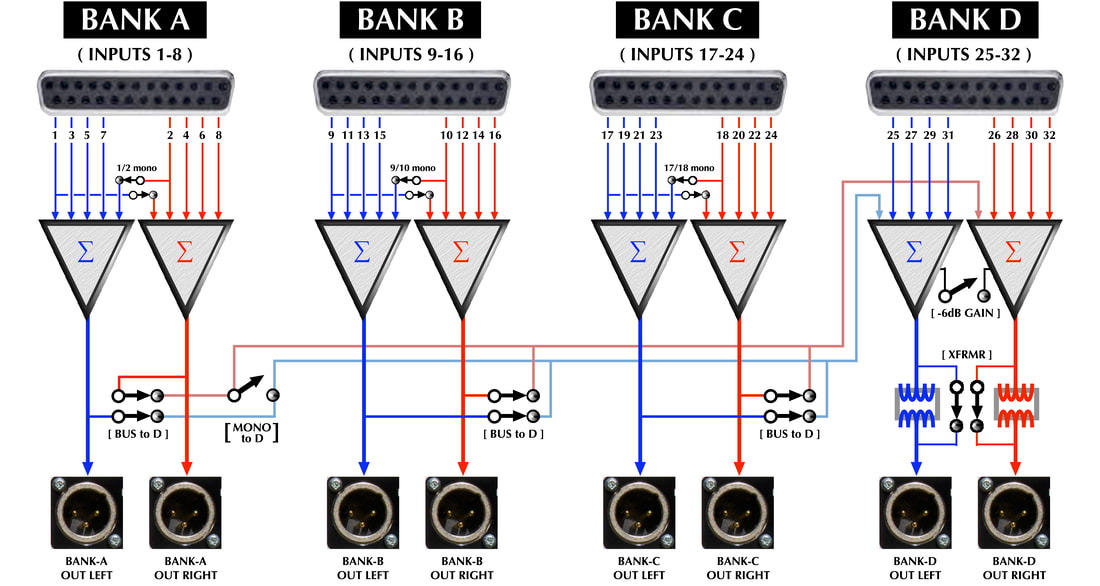
Specifications
|
CMRR: -108dB [60 Hz, transformer in]
Crosstalk: <-103dB [1kHz] THD: 0.00094% [1kHz, +22dBu, 20-20kHz] THD+N: 0.0011% [1kHz, +22dBu, 20-20kHz] SMPTE IMD: 0.0026% [250Hz+8kHz, 4:1] |
Dynamic Range: 127dB
Noise: -98dBu [8x2, Rs=0Ω, 20-20kHz, A-weighted] Max. Input: +29dBu [12kΩ input impedance] Max. Output: +29dBu [10kΩ load, ≤ 0.004% thd] Max. Output: +27.5dBu [600Ω load, ≤ 0.004% thd] |
Bandwidth: DC to 1MHz [+0/-3dB]
Spectral Accuracy: ±0.04dB [20Hz-40kHz] Slew Rate: 600V/µS Linear Phase Deviation: 0.0˚ [20Hz, transfomerless] Linear Phase Deviation: 0.3˚ [20Hz, transfomer In] |
As these specs reveal, SideWinder's attributes are phenomenal. Of note, SideWinder has 2 times lower distortion, 5 times wider bandwidth and 45 times better hum rejection than the next-best product. And, on a per-channel basis, Pueblo Audio delivers this level of performance at the lowest price on the market. Additional F.A.Q. below.
Dimensions: 1U x 19" x 6"
Requires a PS34 power station for operation (sold separately). 6' DC interconnect cable included.
Requires a PS34 power station for operation (sold separately). 6' DC interconnect cable included.
Example 1: Hybrid Mix Down Session
Example 2: Film Score 5.1 DownMix + Stereo Fold-Down
Example 3: Direct To 2-Track Orchestral Session
Why Use Analog Summing?
Why would an external analog summer be desirable when 32bit resolution and up to 192kHz sampling rates are within every ITB mixer's reach? On a practical level they provide a perfectly recallable analog environment where mixers can utilize all that wonderful outboard gear while avoiding multiple DAC/ADC round trips. On an aesthetic level, quality analog summing, along with the good DACs available today, are able to deliver a visceral listening experience not found ITB. Why this should be is hotly debated. But if you hear it... you'll want it. Ensemble, sonority, sound stage, punch - they're all just felt in a more resolved & palpable way. A way that both producers and music consumers tend to crave.
Can SideWinder be Modified?
Absolutely. After a good deal of research, SideWinder's stock configuration was determined to fit a wide range of applications. Even so, no summer will fit every possible scenario. Luckily, the circuit layout lends itself for easy customization so feel free to ask. Examples of modifications include:
- Convert Banks A,B,C to distribution amps forming a 32x2 single-amp summer with a main out plus three active followers.
- Add +11.8dB gain to each amp (instead of unity) to act as a Synth Rack -10dBv to +4dBu Summing Converter.
- Omit Bank-C 's amp and convert Bank-D to a 16x2 single-amp summer. Banks A & B remain 8x2 summers.
- Modify Bank-D's -6dB Gain Switch to boost or attenuate an amount of your choosing (ex.: -10dB, +3dB, etc..)
- Etc...
Why No Insert Switches?
The quick answer is that SideWinder's compact form factor leaves no room for the required additional connectors. Philosophically, their omission was a design choice made in the interest of preserving sound quality. Consider that INSERT switches don't actually insert anything. Cable patching is what performs the insertion. The true function of the so-called "INSERT" switches is to bypass the outboard send-and-return loop. The majority of outboard gear which would be used on a stereo buss will already have a BYPASS switch installed, making "INSERT" switches superfluous.
Take a look at the following figures. Figure A shows a stereo bus FX chain with a stock SideWinder. Figure B shows a hypothetical chain if SideWinder had been fitted with "INSERT" switches.
Take a look at the following figures. Figure A shows a stereo bus FX chain with a stock SideWinder. Figure B shows a hypothetical chain if SideWinder had been fitted with "INSERT" switches.
As can be seen, Figure A is the cleaner and more elegant solution. In contrast, Figure B is a rat's nest. With its greater number of switches, connections and cable lengths, Figure B must necessarily have more error-current flow and signal degradation. Figure A avoids this problem by simply employing a best practices approach to audio interconnection. Not only will Figure A sound better, it will be less expensive to wire up. And no matter how many outboard FX are added to the chain, you will never run out of "INSERT"switches.




